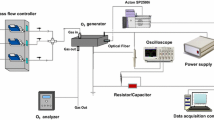Abstract
The energy deposition and the ozone generation in a shielded sliding discharge were compared with those of a simple surface discharge and a pulsed corona discharge in atmospheric pressure air and oxygen. All discharges were generated by applying 160 ns, high voltage pulses. Under the same conditions, the highest energy deposition per pulse was obtained with the shielded sliding discharge. The energy deposition was lower by a factor of four for the surface discharge plasma and by an order of magnitude for the pulsed corona discharge plasma. Replacing air with the more electronegative oxygen caused a decrease in the deposited energy due to electron attachment. The threshold voltage for plasma formation in oxygen in a shielded sliding discharge was approximately 5 kV, three times less than that of the surface discharge (≥15 kV) and four times less than that of the pulsed corona discharge (≥20 kV). A new finding of this study is that, whereas the decrease in energy in the pulsed corona discharge was ≥50 %, and that of the simple surface discharge ≥40 %, it was negligible in the shielded sliding discharge. Since the ozone generation scales with energy density, the results show that plasma reactors based on the nanosecond sliding discharge principle have major advantages in compactness, ignition voltage, and in the use of oxygen, rather than air, compared to surface discharges and corona discharges.




Similar content being viewed by others
References
Wojtowicz JA (2005) Ozone in Kirk–Othmer encyclopedia of chemical technology. Wiley, New York. doi:10.1002/0471238961.1526151423151020.a01.pub2
Siemens WV (1857) Ueber die elektrostatische Induktion und die Verzögerung des Stroms in Flaschendrähten [About the electrostatic induction and the delay of the current in bottles wires]. Ann Phys 178(9):66–122
Takamura N, Matsumoto T, Wang D, Namihira T, Akiyama H (2011) Ozone generation using positive- and negative-nanoseconds pulsed discharges. In: IEEE pulsed power conference (PPC), pp 1300–1303
Buntat Z, Smith IR, Razali NA (2009) Ozone generation using atmospheric pressure glow discharge in air. J Phys D Appl Phys 42(23):235202
Masuda S, Akutsu K, Kuroda M, Awatsu Y, Shibuya Y (1988) A ceramic-based ozonizer using high-frequency discharge. IEEE Trans Ind Appl 24:223–231
Simek M, Pekarek S, Prukner V (2010) Influence of power modulation on ozone production using an AC surface dielectric barrier discharge in oxygen. Plasma Chem Plasma Process 30:607–617
Jodzis S (2012) Effective ozone generation in oxygen using a mesh electrode in an ozonizer with variable linear velocity. Ozone Sci Eng 34:378–386
Kim MH, Cho JH, Ban SB, Choi RY, Kwon EJ, Park SJ, Eden JG (2013) Efficient generation of ozone in arrays of microchannel plasmas. J Phys D Appl Phys 46:305201
Malik MA, Schoenbach KH, Heller R (2014) Coupled surface dielectric barrier discharge reactor-ozone synthesis and nitric oxide conversion from air. Chem Eng J 256:222–229
Malik MA, Schoenbach KH (2014) Nitric oxide conversion and ozone synthesis in a shielded sliding discharge reactor with positive and negative streamers. Plasma Chem Plasma Process 34:93–109
Malik MA (2014) Ozone synthesis using shielded sliding discharge: effect of oxygen content and positive versus negative streamer mode. Ind Eng Chem Res 53:12305–12311
Malik MA, Jiang C, Dhali SK, Heller R, Schoenbach KH (2014) Coupled sliding discharges: a scalable nonthermal plasma system utilizing positive and negative streamers on opposite sides of a dielectric layer. Plasma Chem Plasma Process 34:871–886
Jodzis S (2003) Effect of silica packing on ozone synthesis from oxygen–nitrogen mixtures. Ozone Sci Eng 25:63–72
Chen HL, Lee HM, Chang MB (2006) Enhancement of energy yield for ozone production via packed-bed reactors. Ozone Sci Eng 28:111–118
Huang W, Ren T, Xia W (2007) Ozone generation by hybrid discharge combined with catalysis. Ozone Sci Eng 2:107–112
Belevtsev AA (2013) Charge kinetics in weakly ionized plasma of electronegative gases. High Temp 51(4):435–442
Koo IG, Lee WM (2006) Hollow-cathode based electrical discharge in atmospheric pressure water vapor at wide range of temperature. Japn J Appl Phys 45(10R):7888–7893
Malik MA, Schoenbach KH (2012) New approach for sustaining energetic, efficient and scalable non-equilibrium plasma in water vapours at atmospheric pressure. J Phys D Appl Phys 45(13):132001
Bloshchitsyn V (2010) Review of surface discharge experiments. http://arxiv.org/pdf/1005.5044v1.pdf. Accessed 31 Sep 2013
Yagi S, Tanaka M (1979) Mechanism of ozone generation in air-fed ozonisers. J Phys D Appl Phys 12:1509–1520
Kitayama J, Kuzumoto M (1999) Analysis of ozone generation from air in silent discharge. J Phys D Appl Phys 32:3032–3040
Kogelschatz U, Eliasson B, Hirth M (1989) Ozone generation from oxygen and air: discharge physics and reaction mechanisms. Ozone Sci Eng 10:367–377
Kitayama J, Kuzumoto M (1997) Theoretical and experimental study on ozone generation characteristics of an oxygen-fed ozone generator in silent discharge. J Phys D Appl Phys 30:2453–2461
Jodzis S (2011) Application of technical kinetics for macroscopic analysis of ozone synthesis process. Ind Eng Chem Res 50:6053–6060
Williamson JM, Trump DD, Bletzinger P, Ganguly BN (2006) Comparison of high-voltage ac and pulsed operation of a surface dielectric barrier discharge. J Phys D Appl Phys 39:4400–4406
van Heesch EJM, Winands GJJ, Pemen AJM (2008) Evaluation of pulsed streamer corona experiments to determine the O* radical yield. J Phys D Appl Phys 41:234015
Acknowledgments
This work is supported by a Commonwealth Research Commercialization Fund Grant (MF13-019-Env.) from Virginia’s Center for Innovative Technology, ‘Frank Reidy Fellowship in Environmental Plasma Research’ and with internal funds of the Frank Reidy Research Center for Bioelectrics.
Author information
Authors and Affiliations
Corresponding author
Rights and permissions
About this article
Cite this article
Malik, M.A., Hughes, D., Heller, R. et al. Surface Plasmas Versus Volume Plasma: Energy Deposition and Ozone Generation in Air and Oxygen. Plasma Chem Plasma Process 35, 697–704 (2015). https://doi.org/10.1007/s11090-015-9611-3
Received:
Accepted:
Published:
Issue Date:
DOI: https://doi.org/10.1007/s11090-015-9611-3



